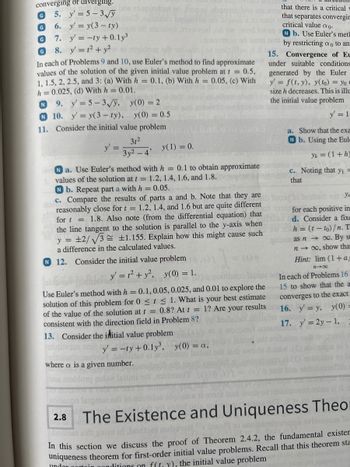
Advanced Engineering Mathematics
10th Edition
ISBN: 9780470458365
Author: Erwin Kreyszig
Publisher: Wiley, John & Sons, Incorporated
expand_more
expand_more
format_list_bulleted
Question
9a

Transcribed Image Text:converging or diverging.
5. y' = 5-3√y
6.
y' = y(3-ty)
7. y'= -ty+0.1y³
8.
G
G
G
In each of Problems 9 and 10, use Euler's method to find approximate
values of the solution of the given initial value problem at t = 0.5,
1, 1.5, 2, 2.5, and 3: (a) With h = 0.1, (b) With h = 0.05, (c) With
h = 0.025, (d) With h = 0.01.
N 9. y'=5-3√y, y(0) = 2
N 10. y'= y(3-ty), y(0) = 0.5
11. Consider the initial value problem
y' =
Lins zsupinted o Rea yyy
y'= 1² + y² ni maldong
31²
3y24
Na. Use Euler's method with h = 0.1 to obtain approximate
values of the solution at t = 1.2, 1.4, 1.6, and 1.8.
N b. Repeat part a with h = 0.05.
c. Compare the results of parts a and b. Note that they are
reasonably close for t = 1.2, 1.4, and 1.6 but are quite different
for t= 1.8. Also note (from the differential equation) that
the line tangent to the solution is parallel to the y-axis when
y = ±2/√√3 ±1.155. Explain how this might cause such
a difference in the calculated values.
N 12. Consider the initial value problem
y' = 1² + y², y(0) = 1.
Use Euler's method with h = 0.1, 0.05, 0.025, and 0.01 to explore the
solution of this problem for 0 < t < 1. What is your best estimate
of the value of the solution at t = 0.8? At t = 1? Are your results
consistent with the direction field in Problem 8?
modsups
y(1) = 0.
13. Consider the initial value problem
fatui
2.8
where a is a given number.
y = -ty+0.1y³, y(0) = a,
that there is a critical
that separates convergir
critical value ao.
N b. Use Euler's meth
by restricting ao to an
15. Convergence of EL
under suitable conditions
generated by the Euler
y' = f(t, y), y(to) = yo
size h decreases. This is illu
the initial value problem
y' = 1
a. Show that the exa
N b. Using the Eul.
Yk= (1 + h)
c. Noting that y₁ =
that
on si Ya
for each positive in
d. Consider a fixe
h=(t-to)/n. T
as n →∞o. By su
n→ ∞, show tha
Hint: lim (1+a/
84x
In each of Problems 16
15 to show that the a
converges to the exact
16. y'= y, y(0) =
17. y' = 2y - 1,
anini
The Existence and Uniqueness Theor
idh aoran al hor
In this section we discuss the proof of Theorem 2.4.2, the fundamental exister
uniqueness theorem for first-order initial value problems. Recall that this theorem sta
conditions on f(t. y), the initial value problem
under contain
pomp
Expert Solution
This question has been solved!
Explore an expertly crafted, step-by-step solution for a thorough understanding of key concepts.
This is a popular solution
Trending nowThis is a popular solution!
Step by stepSolved in 2 steps

Knowledge Booster
Similar questions
Recommended textbooks for you
 Advanced Engineering MathematicsAdvanced MathISBN:9780470458365Author:Erwin KreyszigPublisher:Wiley, John & Sons, Incorporated
Advanced Engineering MathematicsAdvanced MathISBN:9780470458365Author:Erwin KreyszigPublisher:Wiley, John & Sons, Incorporated Numerical Methods for EngineersAdvanced MathISBN:9780073397924Author:Steven C. Chapra Dr., Raymond P. CanalePublisher:McGraw-Hill Education
Numerical Methods for EngineersAdvanced MathISBN:9780073397924Author:Steven C. Chapra Dr., Raymond P. CanalePublisher:McGraw-Hill Education Introductory Mathematics for Engineering Applicat...Advanced MathISBN:9781118141809Author:Nathan KlingbeilPublisher:WILEY
Introductory Mathematics for Engineering Applicat...Advanced MathISBN:9781118141809Author:Nathan KlingbeilPublisher:WILEY Mathematics For Machine TechnologyAdvanced MathISBN:9781337798310Author:Peterson, John.Publisher:Cengage Learning,
Mathematics For Machine TechnologyAdvanced MathISBN:9781337798310Author:Peterson, John.Publisher:Cengage Learning,


Advanced Engineering Mathematics
Advanced Math
ISBN:9780470458365
Author:Erwin Kreyszig
Publisher:Wiley, John & Sons, Incorporated

Numerical Methods for Engineers
Advanced Math
ISBN:9780073397924
Author:Steven C. Chapra Dr., Raymond P. Canale
Publisher:McGraw-Hill Education

Introductory Mathematics for Engineering Applicat...
Advanced Math
ISBN:9781118141809
Author:Nathan Klingbeil
Publisher:WILEY

Mathematics For Machine Technology
Advanced Math
ISBN:9781337798310
Author:Peterson, John.
Publisher:Cengage Learning,

